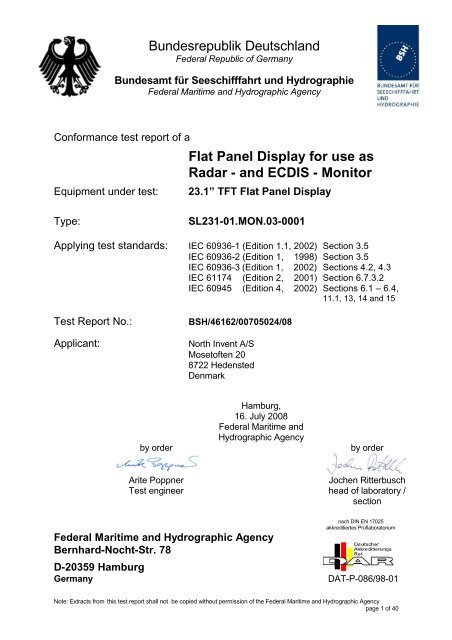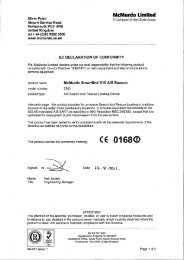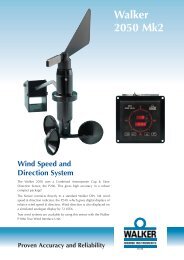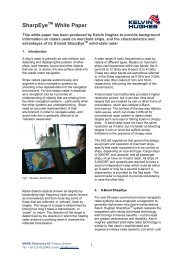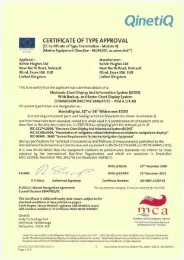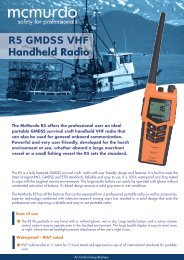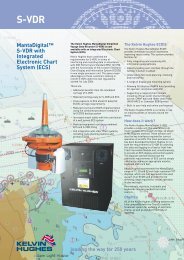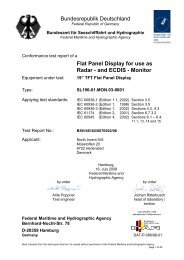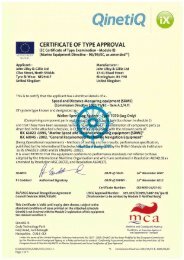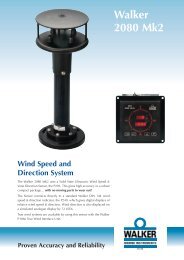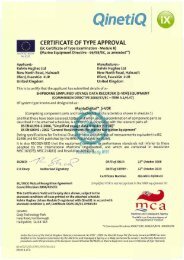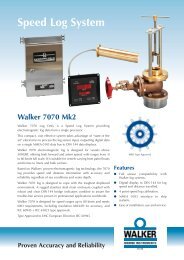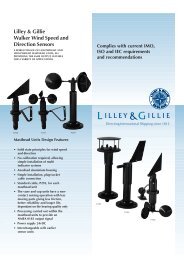BSH Test - MAREL ELECTRONICS SA
BSH Test - MAREL ELECTRONICS SA
BSH Test - MAREL ELECTRONICS SA
You also want an ePaper? Increase the reach of your titles
YUMPU automatically turns print PDFs into web optimized ePapers that Google loves.
Bundesrepublik Deutschland<br />
Federal Republic of Germany<br />
Bundesamt für Seeschifffahrt und Hydrographie<br />
Federal Maritime and Hydrographic Agency<br />
Conformance test report of a<br />
Equipment under test:<br />
Flat Panel Display for use as<br />
Radar - and ECDIS - Monitor<br />
23.1” TFT Flat Panel Display<br />
Type:<br />
SL231-01.MON.03-0001<br />
Applying test standards: IEC 60936-1 (Edition 1.1, 2002) Section 3.5<br />
IEC 60936-2 (Edition 1, 1998) Section 3.5<br />
IEC 60936-3 (Edition 1, 2002) Sections 4.2, 4.3<br />
IEC 61174 (Edition 2, 2001) Section 6.7.3.2<br />
IEC 60945 (Edition 4, 2002) Sections 6.1 – 6.4,<br />
11.1, 13, 14 and 15<br />
<strong>Test</strong> Report No.:<br />
Applicant:<br />
<strong>BSH</strong>/46162/00705024/08<br />
North Invent A/S<br />
Mosetoften 20<br />
8722 Hedensted<br />
Denmark<br />
by order<br />
Hamburg,<br />
16. July 2008<br />
Federal Maritime and<br />
Hydrographic Agency<br />
by order<br />
Arite Poppner<br />
Jochen Ritterbusch<br />
<strong>Test</strong> engineer head of laboratory /<br />
section<br />
Federal Maritime and Hydrographic Agency<br />
Bernhard-Nocht-Str. 78<br />
D-20359 Hamburg<br />
Germany<br />
nach DIN EN 17025<br />
akkreditiertes Prüflaboratorium<br />
DAT-P-086/98-01<br />
Note: Extracts from this test report shall not be copied without permission of the Federal Maritime and Hydrographic Agency<br />
page 1 of 40
Bundesamt für Seeschifffahrt und Hydrographie<br />
Federal Maritime and Hydrographic Agency<br />
<strong>Test</strong> Report No.. <strong>BSH</strong>/46162/0070504/08 Date: 16.07.2008 page 2 of 40
Bundesamt für Seeschifffahrt und Hydrographie<br />
Federal Maritime and Hydrographic Agency<br />
Table of contents:<br />
1 GENERAL............................................................................................................................................... 4<br />
1.1 SUMMARY......................................................................................................................................4<br />
1.2 EQUIPMENT HISTORY .....................................................................................................................7<br />
1.3 TEST ENVIRONMENT.......................................................................................................................7<br />
1.4 LEGEND ........................................................................................................................................8<br />
2 COMPONENTS OF THE EQUIPMENT UNDER TEST ....................................................................... 9<br />
3 TEST INSTALLATION OF THE EQUIPMENT UNDER TEST........................................................... 10<br />
4 TEST RESULTS PART 1 IEC 60936-1 RADAR MONITOR .......................................................... 14<br />
5 TEST RESULTS PART 2 IEC 60936-2 RADAR MONITOR .......................................................... 15<br />
6 TEST RESULTS PART 3 IEC 60936-3 CHART RADAR MONITOR ............................................ 16<br />
7 TEST RESULTS PART 4 IEC 61174 CALIBRATION OF THE MONITOR................................... 17<br />
8 TEST RESULTS PART 5 IEC 60945 ................................................................................................ 19<br />
8.1 GENERAL REQUIREMENTS (SECTION 6.1 - 6.4, 11.1, 13, 14 AND 15)............................................19<br />
ANNEX A MONITOR CALIBRATION ACCORDING TO IEC 61174......................................................... 32<br />
A.1 TEST EQUIPMENT.........................................................................................................................33<br />
A.2 PROTOCOL OF MEASUREMENTS FOR COLOUR CALIBRATION ...........................................................34<br />
A.2.1 Results with Onboard graphics Intel® 945G Express Chipset / VGA-signal (cable: 5m) .....................35<br />
A.2.2 Results with Matrox Millenium G550 / DVI-signal (cable: 1,8 m)...........................................................38<br />
<strong>Test</strong> Report No.. <strong>BSH</strong>/46162/0070504/08 Date: 16.07.2008 page 3 of 40
Bundesamt für Seeschifffahrt und Hydrographie<br />
Federal Maritime and Hydrographic Agency<br />
1 General<br />
1.1 Summary<br />
<strong>Test</strong> standards<br />
IEC 60936-1 (Edition 1.1, 2002)<br />
Maritime navigation and radiocommunication equipment and systems – Radar -<br />
Part 1: Shipborne radar – Performance requirements – Methods of testing and required test results<br />
IEC 60936-2 (Edition 1, 1998)<br />
Maritime navigation and radiocommunication equipment and systems - Radar -<br />
Part 2: Shipborne radar for high-speed craft (HSC) – Methods of testing and required test results<br />
IEC 60936-3 (Edition 1, 2002)<br />
Maritime navigation and radiocommunication equipment and systems - Radar -<br />
Part 3: Radar with chart facilities – Performance requirements, methods of testing and required test<br />
results<br />
IEC 61174 (Edition 2, 2001)<br />
Maritime navigation and radiocommunication equipment and systems -<br />
Electronic chart display and information system (ECDIS) –<br />
Operational and performance requirement, methods of testing and required test results<br />
IEC 60945 (Edition 4, 2002)<br />
Maritime navigation and radiocommunication equipment and systems -<br />
General requirements – Methods of testing and required test results<br />
Normative references:<br />
IMO MSC.64(67) Annex 4 Performance standards for radar equipment<br />
IMO Resolution A.820<br />
Performance standards for navigational radar equipment<br />
for high speed craft<br />
IMO Resolution A.817(19) Performance standards for ECDIS<br />
IHO Special Publication No. 52 (S-52)<br />
Specifications for chart content and display aspects of ECDIS<br />
IHO ECDIS presentation library USERS’ MANUAL<br />
Edition / revision 3.3, March 2004 (S-52, ANNEX A of APPENDIX 2)<br />
<strong>Test</strong> Report No.. <strong>BSH</strong>/46162/0070504/08 Date: 16.07.2008 page 4 of 40
Bundesamt für Seeschifffahrt und Hydrographie<br />
Federal Maritime and Hydrographic Agency<br />
<strong>Test</strong> No. Reference Section Result<br />
(passed/ not passed /<br />
not applicable / not<br />
tested<br />
1 IEC 60936-1 (Edition 1, 1999) 3.5.1 Effective size passed<br />
2 IEC 60936-1 (Edition 1, 1999) 3.5.5 Display information passed<br />
3 IEC 60936-1 (Edition 1, 1999) 3.5.7 Multi-colour display passed<br />
4 IEC 60936-1 (Edition 1, 1999) 3.5.8 Brilliance passed<br />
1 IEC 60936-2 (Edition 1, 1998) 3.5.1 Display passed<br />
2 IEC 60936-2 (Edition 1, 1998) 3.5.2 Brightness adjustment passed<br />
3 IEC 60936-2 (Edition 1, 1998) 3.5.8 Display information passed<br />
1 IEC 60936-3 (Edition 1, 2002) 4.2.2 Display size passed<br />
2 IEC 60936-3 (Edition 1, 2002) 4.2.3 Display resolution passed<br />
3 IEC 60936-3 (Edition 1, 2002) 4.2.4 Display colour passed<br />
4 IEC 60936-3 (Edition 1, 2002) 4.3.2 SENC Information brilliance passed<br />
1 to 6 IEC 61174 (Edition 2, 2001) 6.7.3.2 a) Independent monitor passed<br />
7 to 12 IEC 61174 (Edition 2, 2001) 6.7.3 2 b) passed<br />
1 to 2 IEC 60945 (Edition 4, 2002) 6.1.1 General passed<br />
3 to 10 IEC 60945 (Edition 4, 2002) 6.1.2 Design of control facilities passed<br />
11 to 15 IEC 60945 (Edition 4, 2002) 6.1.3 Operation passed<br />
16 to 20 IEC 60945 (Edition 4, 2002) 6.1.4 Identification passed<br />
21 to 40 IEC 60945 (Edition 4, 2002) 6.1.5 Screen display and Indicators passed<br />
41 to 44 IEC 60945 (Edition 4, 2002) 6.1.6 Voice announcement not applicable<br />
45 to 49 IEC 60945 (Edition 4, 2002) 6.1.7 Safety of operation passed<br />
50 to 55 IEC 60945 (Edition 4, 2002) 6.1.8 Distress alert not applicable<br />
56 to 59 IEC 60945 (Edition 4, 2002) 6.2. Hardware<br />
passed<br />
6.2.1 General<br />
60 to 62 IEC 60945 (Edition 4, 2002) 6.2.2 Alarms and indicators passed<br />
63 to 71 IEC 60945 (Edition 4, 2002) 6.2.3 Illumination passed<br />
72 IEC 60945 (Edition 4, 2002) 6.3 Software<br />
passed<br />
6.3.1 General<br />
73 to 77 IEC 60945 (Edition 4, 2002) 6.3.2 Safety of operation passed<br />
78 to 79 IEC 60945 (Edition 4, 2002) 6.3.3 Monitoring passed<br />
80 IEC 60945 (Edition 4, 2002) 6.3.4 Operation not applicable<br />
81 to 85 IEC 60945 (Edition 4, 2002) 6.4 Inter-unit connection passed<br />
86 to 87 IEC 60945 (Edition 4, 2002) 11.1 Acoustic noise and indication passed<br />
88 to 91 IEC 60945 (Edition 4, 2002) 13 Maintenance passed<br />
92 to 97 IEC 60945 (Edition 4, 2002) 14 Equipment manuals passed<br />
98 to 104 IEC 60945 (Edition 4, 2002) 15 Marking and Identification passed<br />
<strong>Test</strong> Report No.. <strong>BSH</strong>/46162/0070504/08 Date: 16.07.2008 page 5 of 40
Bundesamt für Seeschifffahrt und Hydrographie<br />
Federal Maritime and Hydrographic Agency<br />
Note:<br />
<strong>Test</strong>s were performed by using the RGB signal (VGA) port with an interconnection cable (VGA –<br />
VGA; 5.0 m) for Capax-PC “RS4 v.2” with motherboard type D945GNT/D945GTP and<br />
“onboard” graphics using “intel 945G express “chip set.<br />
<strong>Test</strong>s were performed by using the RGB signal (DVI) port with an interconnection cable (DVI –<br />
DVI; 1.8 m) for test PC with graphics card “Matrox millenium G550“.<br />
The back-light brightness is adjustable either with brightness knob in front of the panel or via<br />
remote control with RS232 interface.<br />
The applied test standard IEC 61174, Edition 2 refers to IHO S-52, Appendix 2 “Colours &<br />
Symbols specification for ECDIS” as normative reference. This publication specifies under<br />
regulation 5.2.3 the colour conversion and tolerances tests as follows:<br />
“The CIE L*u*v* human perception colour model, which is the source of the tolerances<br />
described above has not yet been evaluated at the low luminance of the night colour table, at<br />
which the less colour-sensitive rods of the human eye take over from the daytime cones.<br />
Consequently these tolerances should not be applied to the night table, and for type approval<br />
purposes they are restricted to bright sun table.”<br />
Due to this statement, IEC 61174, Edition 2 does specify instrumental verification for “brightsun”<br />
colour table (DAY) only and this requirement has been taken into account for the test<br />
performed and documented in this report. All other colour tables defined by IHO S-52,<br />
Appendix 2 have been validated by subjective tests only, based on instrumental calibration<br />
and verification procedure as for the “DAY” colour table.<br />
The equipment under test fulfilled the applying requirements for colour presentation at the<br />
time that the tests have been performed. However, no assumptions can be made today about<br />
the possible colour shifts due to the ageing of the monitor in use. If such colour shifts will be<br />
observed later during operation, a re-calibration according to IHO S-52, Appendix 2 has to be<br />
carried out for the individual monitor.<br />
<strong>Test</strong> Report No.. <strong>BSH</strong>/46162/0070504/08 Date: 16.07.2008 page 6 of 40
Bundesamt für Seeschifffahrt und Hydrographie<br />
Federal Maritime and Hydrographic Agency<br />
1.2 Equipment history<br />
Unit<br />
Monitor (23.1”) SL231-01.MON.03-0001 Part No.:<br />
Delivery date 19.02.07 Serial number 00799<br />
PC Capax RS4 v.2 Part No.: -<br />
Delivery date 19.02.07 Serial number 0610FL1278<br />
SW Version: Delivery date 19.02.07 Version no 1.1<br />
Monitor Installation date 19.02.07<br />
1.3 <strong>Test</strong> environment<br />
Here it is intended to record for which time which EUT system is under test.<br />
This test environment is completely equipped as described in Annex A.<br />
Room 720<br />
<strong>Test</strong> engineer<br />
Arite Poppner<br />
Location<br />
<strong>BSH</strong> test laboratory Hamburg<br />
Equipment no Start of test End of test <strong>Test</strong> engineer<br />
06.06.2007 06.08.2007 Arite Poppner<br />
1<br />
(monitor with RS4)<br />
2<br />
(<strong>Test</strong>-PC, G550)<br />
06.06.2007 06.08.2007 Arite Poppner<br />
<strong>Test</strong> Report No.. <strong>BSH</strong>/46162/0070504/08 Date: 16.07.2008 page 7 of 40
Bundesamt für Seeschifffahrt und Hydrographie<br />
Federal Maritime and Hydrographic Agency<br />
1.4 Legend<br />
Result marking:<br />
passed item is ok, test was successful<br />
no colour marking<br />
not applicable item not applicable for the EUT<br />
no colour marking<br />
dev slight deviation, no change required<br />
no colour marking<br />
nok test of a required item was not successful, change required<br />
colour marking: yellow<br />
rec<br />
it is recommended to make a change (no formal requirement)<br />
colour marking: green<br />
NT not yet tested items are marked with a blue background<br />
<strong>Test</strong> Report No.. <strong>BSH</strong>/46162/0070504/08 Date: 16.07.2008 page 8 of 40
Bundesamt für Seeschifffahrt und Hydrographie<br />
Federal Maritime and Hydrographic Agency<br />
2 Components of the equipment under test<br />
Appliance 1 Type/denotation Serial no.<br />
Component 1<br />
23.1” TFT flat panel display<br />
type: SL231-01.MON.03-0001<br />
equipped with anti reflection front cover glass plate<br />
00799<br />
<strong>Test</strong> Report No.. <strong>BSH</strong>/46162/0070504/08 Date: 16.07.2008 page 9 of 40
Bundesamt für Seeschifffahrt und Hydrographie<br />
Federal Maritime and Hydrographic Agency<br />
3 <strong>Test</strong> installation of the equipment under test<br />
Picture 1: Front view of SL231-01.MON.03-0001<br />
Picture 2: Front panel of SL231-01.MON.03-0001<br />
Picture 3: label of 23.1” TFT monitor (example)<br />
<strong>Test</strong> Report No.. <strong>BSH</strong>/46162/0070504/08 Date: 16.07.2008 page 10 of 40
Bundesamt für Seeschifffahrt und Hydrographie<br />
Federal Maritime and Hydrographic Agency<br />
Picture 4: Back view of SL231-01.MON.03-0001<br />
Picture 5: connectors detail of SL231-01.MON.03-0001<br />
<strong>Test</strong> Report No.. <strong>BSH</strong>/46162/0070504/08 Date: 16.07.2008 page 11 of 40
Bundesamt für Seeschifffahrt und Hydrographie<br />
Federal Maritime and Hydrographic Agency<br />
Picture 6: bottom view of SL231-01.MON.03-0001<br />
Picture 7: top view of SL231-01.MON.03-0001<br />
<strong>Test</strong> Report No.. <strong>BSH</strong>/46162/0070504/08 Date: 16.07.2008 page 12 of 40
Bundesamt für Seeschifffahrt und Hydrographie<br />
Federal Maritime and Hydrographic Agency<br />
Picture 8: <strong>Test</strong> set-up with Capax-PC “RS4 v.2”<br />
and Colorimeter YOKOGAWA 3298<br />
<strong>Test</strong> Report No.. <strong>BSH</strong>/46162/0070504/08 Date: 16.07.2008 page 13 of 40
Bundesamt für Seeschifffahrt und Hydrographie<br />
Federal Maritime and Hydrographic Agency<br />
4 <strong>Test</strong> results Part 1 IEC 60936-1 Radar Monitor<br />
No. Of<br />
test<br />
Foundation/<br />
Section<br />
Requirement Result Note<br />
3.5 Display<br />
1 3.5.1 The minimum equipment shall provide, without<br />
external magnification, a daylight display with a<br />
minimum effective diameter within the bearing scale<br />
of not less than:<br />
3.5.1.1 180 mm on ships of 150 GT and more but<br />
less than 1 000 GT;<br />
3.5.1.2 250 mm on ships of 1 000 GT and more but<br />
less than 10 000 GT;<br />
3.5.1.3 340 mm on ships of 10 000 GT and<br />
upwards.<br />
2 3.5.5 (64(67)/Annex 4/3.3.5) Within the effective display<br />
radar video area, the display shall only contain<br />
information which pertains to the use of radar display<br />
for navigation or collision avoidance and which has<br />
to be displayed there because of its association with<br />
a target (e.g. target identifiers, vectors) or because<br />
of some other direct relationships with the radar<br />
display.<br />
3 3.5.7 Multi-colour displays are permitted but the following<br />
requirements shall be met:<br />
3.5.7.1 Target echoes shall be displayed by means<br />
of the same basic colours and echo strength<br />
shall not be displayed in different colours.<br />
3.5.7.2 Additional information may be shown in<br />
different colours.<br />
3.5.7.3 Day and night colours shall be provided.<br />
4 3.5.8 The radar picture and information shall be readable<br />
under all ambient light conditions. There shall be<br />
means of adjusting monitor brilliance. If the light<br />
shield is necessary to facilitate operation of the<br />
display in high ambient light levels, then means shall<br />
be provided for its ready attachment and removal.<br />
3.5.1.1<br />
passed<br />
3.5.1.2<br />
passed<br />
3.5.1.3<br />
not<br />
applicable<br />
passed<br />
passed<br />
passed<br />
active<br />
display:<br />
470.4 (H) x<br />
352.8 (V)<br />
mm<br />
maximum<br />
vertical size<br />
which can<br />
be drawn:<br />
352,8 mm;<br />
resolution<br />
1600x1200<br />
(UXGA)<br />
OSD<br />
display can<br />
be adjusted<br />
for pop up,<br />
e.g. right<br />
side of<br />
display.<br />
EUT<br />
provides<br />
rotary knob<br />
(potentiome<br />
ter) with<br />
mark for<br />
adjusting<br />
monitor<br />
brilliance.<br />
<strong>Test</strong> Report No.. <strong>BSH</strong>/46162/0070504/08 Date: 16.07.2008 page 14 of 40
Bundesamt für Seeschifffahrt und Hydrographie<br />
Federal Maritime and Hydrographic Agency<br />
5 <strong>Test</strong> results Part 2 IEC 60936-2 Radar Monitor<br />
No. Of<br />
test<br />
Foundation/<br />
Section<br />
Requirement Result Note<br />
3.5 Display<br />
1 3.5.1 (A.820/5.1) The equipment shall without external<br />
magnification provide a multi-colour daylight display<br />
with an effective radar picture diameter of not less<br />
than 250mm.<br />
2 3.5.2 (A.820/5.2) Day and night colours shall be provided.<br />
It shall be possible to adjust brightness.<br />
3 3.5.8 (64(67)/Annex 4/3.3.5) Within the effective display<br />
radar video area, the display shall only contain<br />
information which pertains to the use of radar display<br />
for navigation or collision avoidance and which has<br />
to be displayed there because of its association with<br />
a target (e.g. target identifiers, vectors) or because<br />
of some other direct relationships with the radar<br />
display.<br />
passed<br />
passed<br />
passed<br />
EUT<br />
provides<br />
rotary knob<br />
(potentiome<br />
ter) with<br />
mark for<br />
adjusting<br />
monitor<br />
brilliance.<br />
Shall be rechecked<br />
for<br />
each radar<br />
application.<br />
<strong>Test</strong> Report No.. <strong>BSH</strong>/46162/0070504/08 Date: 16.07.2008 page 15 of 40
Bundesamt für Seeschifffahrt und Hydrographie<br />
Federal Maritime and Hydrographic Agency<br />
6 <strong>Test</strong> results Part 3 IEC 60936-3 Chart Radar Monitor<br />
No. of<br />
test<br />
Foundation/<br />
Section<br />
Requirement Result Note<br />
4.2 Display requirements<br />
1 4.2.2 Display size<br />
The equipment shall provide, without external<br />
magnification, a daylight display with a radar<br />
minimum effective diameter within the bearing<br />
scale of not less than 250 mm.<br />
2 4.2.3 The display shall have a minimum resolution of<br />
(L) lines per mm given by L = 800/s, where s is<br />
the smaller dimension of the SENC information<br />
area. (e.g. For the minimum chart area, s = 250<br />
mm and the resolution L = 3,20 lines per mm,<br />
giving a picture unit size of 0,312 mm.)<br />
3 4.2.4 The display shall be multi-colour. The colours<br />
used for navigational lines and symbols and the<br />
SENC information shall harmonise. The SENC<br />
information is permitted to be in shades of grey.<br />
4.3 Display of SENC information<br />
4 4.3.2 SENC information brilliance:<br />
The SENC brilliance shall be adjustable by user<br />
at any time.<br />
passed<br />
passed<br />
passed<br />
passed<br />
pixel number:<br />
1600 x 1200<br />
pixel pitch:<br />
0.294 (H) x<br />
0.294 (V) mm<br />
EUT equipped<br />
with<br />
- rotary knob<br />
with mark at<br />
front side for<br />
adjusting<br />
monitor<br />
brilliance; and<br />
- RS232-<br />
interface for<br />
remote control<br />
of brightness of<br />
the back light.<br />
<strong>Test</strong> Report No.. <strong>BSH</strong>/46162/0070504/08 Date: 16.07.2008 page 16 of 40
Bundesamt für Seeschifffahrt und Hydrographie<br />
Federal Maritime and Hydrographic Agency<br />
7 <strong>Test</strong> results Part 4 IEC 61174 Calibration of the monitor<br />
No. of<br />
test<br />
Foundation/<br />
section<br />
Requirement Result Note<br />
6.7.3.2 Independent monitor<br />
6.7.3.2 a) Calibration verification shall be carried out under<br />
normal conditions as defined in IEC 60945.<br />
Check that for selected colours in the bright sun<br />
colour table of the presentation library, the colours<br />
displayed shall agree with the colours in the presentation<br />
library within the tolerances given in 5.8.4. The<br />
test shall be performed as follows:<br />
1 6.7.3.2 a) 1 If you check a monitor then use a reference computer<br />
which is provided by the manufacturer of the<br />
monitor.<br />
2 6.7.3.2 a) 2 Select a totally black screen provided by the manufacturer.<br />
Check that the level of the black is as required<br />
(less or equal than 0,52 cd/m²).<br />
3 6.7.3.2 a) 3 Select a screen provided by the manufacturer which<br />
has, in a black background, a box of CHWHT<br />
(brightest white). The box size is at least 5 cm per<br />
side but not more than 25% of the total screen area.<br />
Check that the level of CHWHT is within the tolerances<br />
of ∆C* (not greater than 8 units of ∆C*) and ∆L*<br />
(is within 20% of its specified value).<br />
4 6.7.3.2 a) 4 Select a screen provided by the manufacturer which<br />
has, in a black background, a box of CHMGF<br />
(brightest magenta). The box size is at least 5 cm<br />
per side but not more than 25% of the total screen<br />
area. Check that the level of CHMGF is within the<br />
tolerances of ∆C* (not greater than 8 units of ∆C*)<br />
and ∆L* (is within 20% of its specified value).<br />
5 6.7.3.2 a) 5 Select a screen provided by the manufacturer which<br />
has, in a black background, a box of CHYLW<br />
(brightest yellow). The box size is at least 5 cm per<br />
side but not more than 25% of the total screen area.<br />
Check that the level of CHYLW is within the tolerances<br />
of ∆C* (not greater than 8 units of ∆C*) and ∆L*<br />
(is within 20% of its specified value).<br />
6 6.7.3.2 a) 6 Select a screen provided by the manufacturer which<br />
has, in a black background, a box of BKAJ2 (darkest<br />
Grey). The box size is at least 5 cm per side but not<br />
more than 25% of the total screen area. Check that<br />
the level of BKAJ2 is within the tolerances of ∆C*<br />
(not greater than 8 units of ∆C*) and ∆L* (is within<br />
20% of its specified value).<br />
6.7.3.2 b) The Day-black-background, dusk and night tables<br />
shall be tested as follows:<br />
passed<br />
passed<br />
passed<br />
passed<br />
passed<br />
passed<br />
measured:<br />
0.23 cd/m²<br />
VGA<br />
0.23 cd/m²<br />
DVI<br />
measured<br />
results see<br />
Annex 1<br />
measured<br />
results see<br />
Annex 1<br />
measured<br />
results see<br />
Annex 1<br />
measured<br />
results see<br />
Annex 1<br />
<strong>Test</strong> Report No.. <strong>BSH</strong>/46162/0070504/08 Date: 16.07.2008 page 17 of 40
Bundesamt für Seeschifffahrt und Hydrographie<br />
Federal Maritime and Hydrographic Agency<br />
No. of Foundation/<br />
Requirement Result Note<br />
test section<br />
7 6.7.3.2 b) 1 The person conducting the test shall have passed passed<br />
the Ishihara color blindness test taken by mariners<br />
and shall adapt to the night viewing for 10min. before<br />
checking the night display;<br />
6.7.3.2 b) 2 the brightness and contrast controls shall be set to<br />
their calibrated settings;<br />
6.7.3.2 b) 3 while the display is off, adjust the light level reflected<br />
from white paper positioned on the display screen to<br />
the following values (in table 2) :<br />
Table 2 – Light levels<br />
Time period<br />
Luminance level for the test(value limits)<br />
8 6.7.3.2 b)<br />
3.1<br />
Day-black background<br />
(200cd/m², ± 50%)<br />
passed measured:<br />
103.4 cd/m²<br />
VGA;<br />
105.7 cd/m²<br />
9 6.7.3.2 b)<br />
3.2<br />
Dusk<br />
(10cd/m², ± 50%)<br />
10 6.7.3.2 b)<br />
3.3<br />
Night<br />
(darkness)<br />
11 6.7.3.2 b) 4 Under each of the above conditions display the<br />
appropriate color differentiation test diagrams<br />
described in S-52, appendix 2, annex A.6 for above<br />
tables. Select each table in turn and ensure that:<br />
- each foreground stripes is clearly distinguished<br />
from its background;<br />
- the foreground stripes representing yellow,<br />
orange, magenta, green, blue and grey may be<br />
clearly identified.<br />
12 6.7.3.2 b) 5 Under each of the above conditions display the black<br />
adjust boxes available from ECDIS chart 1 (the chart<br />
AA5C1ABO of ECDIS chart 1). Select each table in<br />
turn and ensure that:<br />
- symbol BLKADJ01 is clearly distinguished from its<br />
background.<br />
passed<br />
passed<br />
passed<br />
passed<br />
DVI<br />
measured:<br />
13.67 cd/m²<br />
VGA<br />
12.53 cd/m²<br />
DVI.<br />
<strong>Test</strong> Report No.. <strong>BSH</strong>/46162/0070504/08 Date: 16.07.2008 page 18 of 40
Bundesamt für Seeschifffahrt und Hydrographie<br />
Federal Maritime and Hydrographic Agency<br />
8 <strong>Test</strong> results Part 5 IEC 60945<br />
8.1 General Requirements<br />
(Section 6.1 - 6.4, 11.1, 13, 14 and 15)<br />
No.<br />
of<br />
test<br />
Foundation<br />
/ section<br />
6.<br />
6.1<br />
Requirement Result Note<br />
Operational checks<br />
Ergonomics and HMI<br />
1 The EUT shall be checked to ensure compliance<br />
with the specific requirements as detailed below.<br />
The checks carried out shall be described and<br />
the results noted in the test report.<br />
IEC 60945<br />
6.1.1 General<br />
2 b) A check shall be made that all modes of<br />
operation required by the equipment standard are<br />
available, and that they may be controlled over<br />
the required range. Use shall be made of every<br />
position of every control provided to ensure that it<br />
performs the function for which it is identified and<br />
that it operates in the expected manner.<br />
IEC 60945<br />
6.1.2. Design of control facilities<br />
3 a) Check that the number of operational controls,<br />
their design and manner of function, location,<br />
arrangement and size provide for simple, quick<br />
and effective operation of the EUT. Check that<br />
the controls are logically grouped according to<br />
their function.<br />
4 b) Check that the shape and size of each control is<br />
appropriate to its mode of operation. In the case<br />
of trackballs, joysticks and mice check that the<br />
controller can produce any combination of x and<br />
y axis output values and that the controller does<br />
not drive the follower off the edge of the screen.<br />
In the case of joysticks, check that there is a<br />
“home position” with a capability for a return to<br />
that point.<br />
5 c) In the case of touch screens check that the<br />
dimension of the response area for a push to<br />
activate operation is a minimum of 15 mm height<br />
and width and the force required for operation is<br />
a maximum of 1,5 N where applicable.<br />
See below<br />
passed<br />
passed<br />
passed<br />
not<br />
applicable<br />
remote control<br />
with RS232<br />
interface and<br />
brightness<br />
adjustment with<br />
rotary knob.<br />
EUT provides<br />
rotary knob with<br />
mark for<br />
adjustment of<br />
“brightness” and<br />
push buttons for<br />
“ON/OFF”;<br />
“MENU”<br />
<strong>Test</strong> Report No.. <strong>BSH</strong>/46162/0070504/08 Date: 16.07.2008 page 19 of 40
Bundesamt für Seeschifffahrt und Hydrographie<br />
Federal Maritime and Hydrographic Agency<br />
No.<br />
of<br />
test<br />
Foundation<br />
/ section<br />
Requirement Result Note<br />
6 d) Check that information presentation is suited to<br />
the maximum expected rate of change of<br />
information. Analogue presentation is generally<br />
more suited to rapid change than digital.<br />
7 e) Check that rotating controls and indicators turn<br />
clockwise for increased function.<br />
8 f) Check that linear controls and indicators move<br />
upwards or to the right for increased value or<br />
effect.<br />
9 g) Check that where users must rapidly discern<br />
directional change, digital displays are provided<br />
with indications of directions of change.<br />
10 h) Check that equipment elements relating to<br />
control, and indicators associated with control,<br />
are readily distinguishable from elements provided<br />
for other functions, such as equipment setup.<br />
IEC 60945<br />
6.1.3 Operation (see 4.2.1.3)<br />
11 a (1) Check that all operational controls permit normal<br />
adjustments to be easily performed, and are<br />
arranged in a manner that minimises the chance<br />
of inadvertent operation.<br />
12 a (2) Check that controls not required for normal<br />
operation and which may affect performance are<br />
not readily accessible.<br />
13 b) Check all operational controls and indications<br />
for ease of use and correctness, and for general<br />
suitability related to their function and environment,<br />
for example expected ambient illumination<br />
and sound.<br />
14 c) Check that the operation of a control does not<br />
cause obscuration of its related indicator where<br />
observation of the indicator is necessary for<br />
making the adjustment.<br />
15 d) Check that in all operations there is a clearly<br />
marked or consistent simple action to recover<br />
from a mistaken choice or to leave an unwanted<br />
state. Check that it is always possible for a user<br />
to start, interrupt, resume and end an operation.<br />
passed<br />
passed<br />
passed<br />
not<br />
applicable<br />
passed<br />
passed<br />
passed<br />
passed<br />
passed<br />
not<br />
applicable<br />
checked for OSD<br />
menu.<br />
EUT provides<br />
rotary knob with<br />
mark for<br />
adjustment of<br />
“brightness”.<br />
only available at<br />
OSD display in<br />
“service mode”.<br />
set-up controls<br />
(push buttons)<br />
only active after<br />
pressing [LOCK]<br />
push button for<br />
more than 5 (five)<br />
seconds.<br />
set-up controls<br />
(push buttons)<br />
only active after<br />
pressing [LOCK]<br />
push button for<br />
more than 5 (five)<br />
seconds.<br />
EUT provides LED<br />
for AC and DC<br />
power supply<br />
indication.<br />
<strong>Test</strong> Report No.. <strong>BSH</strong>/46162/0070504/08 Date: 16.07.2008 page 20 of 40
Bundesamt für Seeschifffahrt und Hydrographie<br />
Federal Maritime and Hydrographic Agency<br />
No.<br />
of<br />
test<br />
Foundation<br />
/ section<br />
Requirement Result Note<br />
IEC 60945<br />
6.1.4 Identification<br />
16 a) Check that all operational controls and indicators<br />
are easy to identify and read from the position<br />
where the equipment is normally operated.<br />
17 b) (1) Check that instrument and indicator character<br />
type is simple and clear. The character height<br />
(mm) shall not be less than 3,5 times the reading<br />
distance in metres, and the nominal character<br />
width shall be 0,7 times the character height.<br />
18 b) (2) Check that instruments meant to be operated, or<br />
fitted in connection with controls are readable<br />
from a distance of at least 1 m, and that other<br />
instruments are readable from a distance of at<br />
least 2 m.<br />
19 c) Check that the controls and indicators are<br />
identified in English, and that the identifications<br />
provided in the equipment standard are used.<br />
20 d) Check that indicators are satisfactorily positioned<br />
relative to the operator line of sight, and are not<br />
obscured when operating associated controls<br />
under normal operating conditions.<br />
IEC 60945<br />
6.1.5<br />
Screen display<br />
and Indicators (see 4.2.1.5)<br />
21 a) Check that menus are grouped according to the<br />
task environment. Check that hierarchical menu<br />
structures have been designed to minimise the<br />
number of steps required and that the user has<br />
an indication of current position in the menu.<br />
22 b) If menu selections are made of keyed codes,<br />
check that each code is the first letter or letters of<br />
the displayed option label rather than an arbitrary<br />
letter.<br />
23 c) Check that a menu displays only those options<br />
currently available in the current context to the<br />
user. Check that menu items are highlighted<br />
when the cursor passes over them.<br />
24 d) Check that for menu items that can be in an “On”<br />
or “Off” state the “On” state should be indicated<br />
by making the item perceptually distinct and that<br />
selection of menu items with “On” and “Off”<br />
states change their state.<br />
25 e) Check that items which appear the same behave<br />
consistently by, for instance,<br />
1) checking for consistent display format and<br />
selection logic in hierarchical menus,<br />
2) checking that menus used in different displays<br />
are consistent,<br />
3) checking that menus are displayed in<br />
passed<br />
passed<br />
passed<br />
passed<br />
passed<br />
passed<br />
not<br />
applicable<br />
passed<br />
passed<br />
1) passed<br />
2) not<br />
applicable<br />
3) passed<br />
4) passed<br />
checked for OSD<br />
menu.<br />
checked for OSD<br />
menu.<br />
Power LED<br />
located adjacent<br />
to power ON/OFF<br />
push button.<br />
checked for OSD<br />
menu<br />
checked for OSD<br />
menu<br />
checked for OSD<br />
menu<br />
checked for OSD<br />
menu<br />
<strong>Test</strong> Report No.. <strong>BSH</strong>/46162/0070504/08 Date: 16.07.2008 page 21 of 40
Bundesamt für Seeschifffahrt und Hydrographie<br />
Federal Maritime and Hydrographic Agency<br />
No.<br />
of<br />
test<br />
Foundation<br />
/ section<br />
Requirement Result Note<br />
consistent screen locations,<br />
4) checking for consistent input prompts and<br />
checking that labels are consistent.<br />
26 f) Check that the user does not have to remember<br />
information from one part of a dialogue to another.<br />
27 g) Check that the system employs marine terminology<br />
conforming with the SMCPs where appropriate.<br />
28 h) Check that displayed text is easy to understand<br />
wherever possible.<br />
29 i) Check that where additional on-line help is available<br />
it is in task dependent form, easy to search<br />
and list the steps to be carried out.<br />
30 j) Check that in all operations the system state is<br />
observable with essential data displayed.<br />
31 k) Check that all information required by the user to<br />
perform an operation is available on the current<br />
display.<br />
32 l) Check that feedback timing is consistent with the<br />
task requirements. Check that there is a clear<br />
feedback from any action within a short time.<br />
Check that where a perceptible delay in response<br />
occurs, a visible indication is given.<br />
33 m) Check that it is possible at any step of a screen<br />
supported operation to return with one action to<br />
the original status before the operation was<br />
started.<br />
34 n) Check that any mode in use is distinctively identified<br />
by the display.<br />
35 o) Check that displays present the simplest<br />
information consistent with their function, information<br />
irrelevant to the task is not displayed, and<br />
extraneous text and graphics are not present.<br />
36 p) Check that displayed text is clearly legible to the<br />
user. Check that the font and size of alphanumeric<br />
characters are consistent. For any font<br />
used, check that it is possible to clearly distinguish<br />
between the characters: X and K, T and<br />
Y, I and L, I and 1, 0, O and Q, S and 5 and U<br />
and V.<br />
37 q) Check that the unit of measure is indicated for<br />
any data.<br />
38 r) Check that all information is presented on a<br />
background of high contrast.<br />
39 s) Check that highlighting is easily recognisable and<br />
is disabled when it is no longer applicable.<br />
passed<br />
not<br />
applicable<br />
passed<br />
not<br />
applicable<br />
not<br />
applicable<br />
passed<br />
passed<br />
passed<br />
passed<br />
passed<br />
passed<br />
passed<br />
passed<br />
passed<br />
checked for OSD<br />
menu<br />
checked for OSD<br />
menu<br />
checked for OSD<br />
menu<br />
checked for OSD<br />
menu<br />
checked for OSD<br />
menu<br />
checked for OSD<br />
menu<br />
checked for OSD<br />
menu<br />
checked for OSD<br />
menu<br />
checked for OSD<br />
menu<br />
<strong>Test</strong> Report No.. <strong>BSH</strong>/46162/0070504/08 Date: 16.07.2008 page 22 of 40
Bundesamt für Seeschifffahrt und Hydrographie<br />
Federal Maritime and Hydrographic Agency<br />
No.<br />
of<br />
test<br />
Foundation<br />
/ section<br />
Requirement Result Note<br />
40 t) Check that flashing is only used to signal an<br />
alarm and that only a small percentage of the<br />
screen is flashing at any one time. Check that if a<br />
user is required to read alarm text a marker<br />
symbol shall flash rather than the text. Check that<br />
no more than two flash rates are used and that<br />
they are then time synchronised.<br />
IEC 60945<br />
6.1.6 Voice announcement (see 4.2.1.6)<br />
41 a) Check that voice announcements are in plain<br />
language, using marine terminology conforming<br />
with the SMCPs where appropriate, and in the<br />
English language.<br />
42 b) Check that it is possible to adjust the volume to<br />
extinction and that sudden changes in loudness<br />
do not occur.<br />
43 c) Check that voice announcements stop when their<br />
associated indication or alarm is acknowledged.<br />
44 d) Check that failure of the voice announcement<br />
system by disabling the loudspeaker, does not<br />
degrade the operation of the provided indicators<br />
and alarms.<br />
IEC 60945<br />
6.1.7 Safety of operation (see 4.2.1.7)<br />
45 a) Check that the system attempts to prevent ascertainable<br />
user-action error from occurring.<br />
46 b) Check that all actions that may be irreversible,<br />
require a confirmation before proceeding.<br />
47 c) Check that when an action causes a detectable<br />
error the system gives clear feedback such as by<br />
including UNDO and/or REDO options where<br />
possible.<br />
48 d) Check that the EUT makes use of any quality<br />
indication contained in the input from other systems<br />
or sources.<br />
49 e) Check that the user has available means to<br />
return to a known safe state with a single action.<br />
IEC 60945<br />
6.1.8 Distress alert (see 4.2.1.8)<br />
50 a) Check that a distress alert is only activated by<br />
means of a dedicated distress button, and that it<br />
is not a key of an ITU-T digital input panel, or of<br />
an ISO keyboard on the equipment. Check that<br />
the button is physically separated from functional<br />
buttons/keys used for normal operation. Check<br />
that the button is a single button used for no other<br />
purpose than to initiate a distress alert.<br />
not<br />
applicable<br />
not<br />
applicable<br />
not<br />
applicable<br />
not<br />
applicable<br />
not<br />
applicable<br />
passed<br />
not<br />
applicable<br />
passed<br />
passed<br />
passed<br />
not<br />
applicable<br />
EUT provides no<br />
alarms<br />
EUT does not<br />
provide any voice<br />
alarm functions.<br />
e.g. indication:<br />
“No input signal”<br />
EUT does not<br />
provide any<br />
distress<br />
functionality<br />
<strong>Test</strong> Report No.. <strong>BSH</strong>/46162/0070504/08 Date: 16.07.2008 page 23 of 40
Bundesamt für Seeschifffahrt und Hydrographie<br />
Federal Maritime and Hydrographic Agency<br />
No.<br />
of<br />
test<br />
Foundation<br />
/ section<br />
Requirement Result Note<br />
51 b) Check that the dedicated distress button Is<br />
clearly identified by being red in colour and<br />
marked “DISTRESS”. Where a non-transparent<br />
protective lid or cover is used check that this is<br />
also marked “DISTRESS”.<br />
52 c) Check that the dedicated distress button is protected<br />
against inadvertent operation by means of<br />
a spring loaded lid or cover permanently attached<br />
to the equipment, for example by hinges. Check<br />
that it is not necessary for a user to remove<br />
additional seals or to break the lid or cover in<br />
order to operate the distress button.<br />
53 d) Check that the distress alert initiation requires at<br />
least two independent actions. Lifting the protective<br />
lid or cover is considered as the first<br />
action. Pressing the distress button is considered<br />
as the second independent action.<br />
54 e) Check that the equipment indicates the status of<br />
a distress alert transmission by checking that the<br />
distress button generates a visible and audible<br />
indication. Check that when the distress button is<br />
pressed a flashing light and intermittent acoustic<br />
signal start immediately. Check that after the<br />
distress button has been pressed for at least 3 s,<br />
the transmission of the distress alert is initiated<br />
and the indication becomes steady.<br />
55 f) Check that it is not possible to interrupt the<br />
transmission of a distress alert or distress message<br />
which is in progress, but that it is possible to<br />
interrupt repetitive transmissions of a distress<br />
message.<br />
IEC 60945<br />
6.2<br />
6.2.1<br />
Hardware<br />
General (see 4.2.2.1)<br />
56 a) Check that provision has been made for the<br />
removal of, or for blocking off, the position of<br />
controls of any optional facilities which are not<br />
fitted.<br />
57 b) Check that operational controls, the inadvertent<br />
exercise of which could switch off the equipment,<br />
lead to performance degradation, or to false<br />
indications not obvious to the operator, are<br />
specially protected against unintentional operation.<br />
58 c) Check that the design of the EUT is such that<br />
misuse of the controls required for normal operation,<br />
and which are accessible to the operator,<br />
shall not cause damage to the equipment or<br />
not<br />
applicable<br />
not<br />
applicable<br />
not<br />
applicable<br />
not<br />
applicable<br />
not<br />
applicable<br />
passed<br />
passed<br />
passed<br />
The power “on/off”<br />
push button at the<br />
front of the cover<br />
has to be pressed<br />
more than 5<br />
seconds to switch<br />
off the EUT.<br />
<strong>Test</strong> Report No.. <strong>BSH</strong>/46162/0070504/08 Date: 16.07.2008 page 24 of 40
Bundesamt für Seeschifffahrt und Hydrographie<br />
Federal Maritime and Hydrographic Agency<br />
No.<br />
of<br />
test<br />
Foundation<br />
/ section<br />
Requirement Result Note<br />
injury to personnel.<br />
59 d) Check that where a digital input panel with the<br />
digits “0” to “9” is provided, the digits are<br />
arranged to conform with ITU-T Recommendation<br />
E.161 (4x3 array) or, alternatively, where<br />
an alpha-numeric keyboard layout, as used on<br />
office machinery and data processing equipment,<br />
is provided, the digits “0” to “9” are arranged to<br />
conform with ISO 3791.<br />
IEC 60945<br />
6.2.2 Alarms and indicators (see 4.2.2.2)<br />
60 a) Check that the EUT is provided with facilities<br />
which permit the testing of all operational<br />
indicators (alarm, warning and routine), displays<br />
and audible devices. Check audible alarms as<br />
described in 11.1.<br />
61 b) Check that alarm indications are red, or if on<br />
displays, red or otherwise highlighted.<br />
62 c) Check that warning and alarm indications show<br />
no self-illumination, except to outline the alarm<br />
area on CRT or LCD displays, in the “safe”<br />
condition, and that any indirect illumination is low<br />
enough to avoid false indications.<br />
IEC 60945<br />
6.2.3 Illumination (see 4.2.2.3)<br />
63 a) Check that any illumination provided in the EUT<br />
is adequate for operation of the equipment under<br />
all expected conditions of ambient illumination.<br />
Check that it can be adjusted for night use so that<br />
the night vision of the officer of the watch is not<br />
harmed by it.<br />
64 b) Check that means are provided for dimming the<br />
output of any light source of the equipment which<br />
is capable of interfering with navigation.<br />
65 c) Check that any external illumination required is<br />
clearly identified in the equipment manual.<br />
66 d) Check that warning and alarm indicator lamps<br />
cannot be dimmed below reading intensity.<br />
not<br />
applicable<br />
passed<br />
passed<br />
passed<br />
passed<br />
passed<br />
not<br />
applicable<br />
passed<br />
EUT provides LED<br />
in front side for<br />
indication of power<br />
supply status.<br />
EUT equipped<br />
with “power” LED<br />
which will be<br />
dimmed with all<br />
over brightness of<br />
the screen.<br />
EUT is equipped<br />
with rotary knob at<br />
front side for<br />
adjustment of<br />
brilliance and with<br />
RS232 interface<br />
for remote control<br />
of brightness of<br />
the backlight.<br />
For using as<br />
ECDIS monitor<br />
the EUT provides<br />
RS-232 interface<br />
for adjustment of<br />
the display back<br />
light.<br />
No external<br />
illumination<br />
required.<br />
<strong>Test</strong> Report No.. <strong>BSH</strong>/46162/0070504/08 Date: 16.07.2008 page 25 of 40
Bundesamt für Seeschifffahrt und Hydrographie<br />
Federal Maritime and Hydrographic Agency<br />
No.<br />
of<br />
test<br />
Foundation<br />
/ section<br />
Requirement Result Note<br />
67 e) Check that the illumination dazzle-free and<br />
adjustable to extinction, except for those warning<br />
and alarm indicators which are illuminated in the<br />
warning/alarm condition, and indicators required<br />
for equipment reactivation or distress alerting,<br />
which are to be clearly visible in all appropriate<br />
conditions of ambient illumination.<br />
68 f) Check that controls which are not illuminated,<br />
such as tracker balls, are locatable easily and<br />
unambiguously by tactile means.<br />
69 g) Check that all information is presented with high<br />
contrast on a low-reflectance background which<br />
emits negligible light at night.<br />
70 h) Check that transparent covers to instruments<br />
cannot cause reflections which reduce readability<br />
to an unacceptable level.<br />
71 i) Check that adjustable dimming from full<br />
brightness is provided for all lamps which are to<br />
be used in conditions of varying ambient illumination.<br />
IEC 60945<br />
6.3<br />
6.3.1<br />
Software<br />
General<br />
72 6.3.1 Check documentation for compliance with<br />
4.2.3.1.:<br />
The code of practice employed in the design and<br />
testing of the software integral to the operation of<br />
the equipment under test shall be specified and<br />
conform to a quality control system audited by a<br />
competent authority. The code of practice shall<br />
define the methodology used in the development<br />
of the software and the standards applied. It<br />
shall, amongst others, include the following<br />
criteria:<br />
– complex software shall be structured to support<br />
separate testing of single modules or of groups of<br />
associated modules. Functions of safety<br />
protection linked with control functions shall<br />
always give priority to safety.<br />
– the structure shall support maintenance and<br />
up-dates of software by minimizing the risk of<br />
undetected problems and failures.<br />
The manufacturer shall supply documentation<br />
passed<br />
passed<br />
passed<br />
passed<br />
passed<br />
passed<br />
EUT is equipped<br />
with rotary knob<br />
for adjustment of<br />
brightness<br />
use of colour<br />
tables according<br />
S-52 / IEC 61174<br />
TFT display<br />
equipped with<br />
special anti<br />
reflection front<br />
cover glass.<br />
EUT equipped<br />
with “power” LED<br />
which will be<br />
dimmed with all<br />
over brightness of<br />
the screen.<br />
<strong>Test</strong> Report No.. <strong>BSH</strong>/46162/0070504/08 Date: 16.07.2008 page 26 of 40
Bundesamt für Seeschifffahrt und Hydrographie<br />
Federal Maritime and Hydrographic Agency<br />
No.<br />
of<br />
test<br />
Foundation<br />
/ section<br />
Requirement Result Note<br />
demonstrating that the software of the EUT is<br />
Developed and tested according to the code of<br />
practice and the requirements of 4.2.3 e.g. by<br />
block, data flow or status diagram.<br />
IEC 60945<br />
6.3.2 Safety of operation (see 4.2.3.2)<br />
73 a) Check documentation for compliance with<br />
4.2.3.2.:<br />
Facilities shall be provided to protect all<br />
operational software incorporated in the<br />
equipment.<br />
Any software required in an equipment to<br />
facilitate operation in accordance with its<br />
equipment standard, including that for its initial<br />
activation/reactivation, shall be permanently<br />
installed with the equipment, in such a way that it<br />
is not possible for the user to have access to this<br />
software.<br />
It shall not be possible for the operator to<br />
augment, amend or erase, during normal use,<br />
any program software in the equipment required<br />
for operation in accordance with the equipment<br />
standard.<br />
Data used during operation and stored in the<br />
system shall be protected in such a way, that<br />
necessary modifications and amendments by the<br />
user cannot endanger its integrity and<br />
correctness.<br />
Default values shall be inserted whenever<br />
relevant to facilitate the required operation of the<br />
equipment.<br />
Display and update of essential information<br />
available in the equipment as well as safety<br />
related functions shall not be inhibited due to<br />
operation of the equipment in any particular<br />
mode, for example dialogue mode.<br />
When presented information is uncertain or<br />
derived from conflicting sources, the equipment<br />
shall indicate this.<br />
passed<br />
Software fixed on<br />
EEPROM<br />
<strong>Test</strong> Report No.. <strong>BSH</strong>/46162/0070504/08 Date: 16.07.2008 page 27 of 40
Bundesamt für Seeschifffahrt und Hydrographie<br />
Federal Maritime and Hydrographic Agency<br />
No.<br />
of<br />
test<br />
Foundation<br />
/ section<br />
Requirement Result Note<br />
74 b) Check that software defaults, where applicable,<br />
are inserted in all modes of operation and that<br />
the default value:<br />
– facilitates the preferred or expected operation<br />
of the equipment in accordance with the<br />
applicable equipment standards,<br />
– does not lead to an unexpected or invalid<br />
operation and<br />
– has the effect of minimising the number of<br />
inputs or transmissions into the system under<br />
which it operates.<br />
75 c) Check that the software prevents an operation or<br />
warns an operator when attempting an input that<br />
leads to an invalid operation of the equipment.<br />
76 d) Check that the operator has the possibility to<br />
choose a value other than the default value.<br />
77 e) Check that operations not required for normal<br />
operation, or which may adversely affect system<br />
performance, are not readily accessible.<br />
IEC 60945<br />
6.3.3 Monitoring (see 4.2.3.3)<br />
78 (1) Check documentation for compliance with<br />
4.2.3.3. The manufacturer shall provide information<br />
on how to produce a non-recoverable error.<br />
79 (2) Carry out the non-automatically recoverable error<br />
according to the above information. Check that<br />
the alarm can be recognised as noted in the<br />
manufacturers documentation.<br />
IEC 60945<br />
6.3.4 Operation (see 4.2.3.4)<br />
80 6.3.4 Check documentation for compliance with<br />
4.2.3.4. :<br />
The system may allow function keys to speed up<br />
selection of common sequences.<br />
IEC 60945<br />
6.4 Inter-unit connection (see 4.2.4)<br />
81 6.4 (1) Check with the manufacturer of the EUT, using<br />
equipment documentation if necessary, that<br />
when it is connected to, and operating with, other<br />
units of equipment, arrangements have been<br />
provided to maintain the performance of the EUT<br />
passed<br />
not<br />
applicable<br />
passed<br />
passed<br />
passed<br />
passed<br />
not<br />
applicable<br />
see below<br />
can be called up<br />
via OSD menu<br />
“Tools” and press<br />
“Factory Defaults”.<br />
tested for OSD<br />
menu<br />
Set-up controls<br />
(push buttons)<br />
only active after<br />
pressing [LOCK]<br />
push button for<br />
more than 5<br />
seconds.<br />
see Sea Line MK3<br />
User’s Manual<br />
version 1.2, June<br />
2008, 3.3 Trouble<br />
Shooting<br />
see Sea Line MK3<br />
User’s Manual<br />
version 1.2, June<br />
2008, 3.3 Trouble<br />
Shooting<br />
EUT doesn’t<br />
provide any hot<br />
keys.<br />
<strong>Test</strong> Report No.. <strong>BSH</strong>/46162/0070504/08 Date: 16.07.2008 page 28 of 40
Bundesamt für Seeschifffahrt und Hydrographie<br />
Federal Maritime and Hydrographic Agency<br />
No.<br />
of<br />
test<br />
Foundation<br />
/ section<br />
Requirement Result Note<br />
and of the other units. In particular:<br />
82 a) check that the software interfaces between the<br />
EUT and other equipment are tested, and that<br />
special test software is provided for this purpose<br />
if necessary;<br />
83 b) 1) ensure that arrangements have been made to<br />
achieve electrical separation and isolation between<br />
the EUT and the equipment to which it<br />
may be connected, if appropriate, such as by<br />
checking that:<br />
1) an exchange of any signals between units is<br />
carried out with minimum effect on the signal<br />
source;<br />
84 b) 2) 2) there is no loading of circuits or mismatch of<br />
transmission lines, particularly on high-frequency<br />
or fast-rise time signals;<br />
85 b) 3) 3) a capability exists of sustaining a 1 kV isolation<br />
between units of equipment.<br />
IEC 60945<br />
11.1<br />
11.1.3<br />
Acoustic noise and signals<br />
Required result<br />
(all equipment intended for installation in wheelhouse<br />
and bridge wings) (see 4.5.2)<br />
4.5.2<br />
(A.694/6.2) Mechanical noise from all units shall be<br />
limited so as not to prejudice the hearing of sounds on<br />
which the safety of the ship might depend.<br />
86 (1) The acoustic pressure shall not exceed a level of<br />
60 dB(A) at a distant of 1 m from any part of the<br />
EUT.<br />
87 (2) With audible alarms switched on, the acoustic<br />
noise pressure of an alarm shall be at least 75<br />
dB(A) but not greater than 85 dB(A) at a distant<br />
of 1 m from any part of the EUT which is accessible<br />
for its operation.<br />
IEC 60945<br />
13 Maintenance<br />
(all equipment categories)<br />
The EUT shall be checked for conformity with the<br />
requirements of 4.7, paying due regard to any<br />
restriction likely to be imposed by the installation<br />
spatial environment.<br />
passed<br />
see below<br />
passed<br />
passed<br />
see below<br />
passed<br />
not<br />
applicable<br />
see below<br />
VE<strong>SA</strong> video mode<br />
standard<br />
VE<strong>SA</strong> video mode<br />
standard and RS-<br />
232 according<br />
ITU-T X.27/V.11<br />
(opto-isolated)<br />
EUT doesn’t<br />
provide any<br />
acoustic alarm.<br />
<strong>Test</strong> Report No.. <strong>BSH</strong>/46162/0070504/08 Date: 16.07.2008 page 29 of 40
Bundesamt für Seeschifffahrt und Hydrographie<br />
Federal Maritime and Hydrographic Agency<br />
No.<br />
of<br />
test<br />
Foundation<br />
/ section<br />
Requirement Result Note<br />
88 4.7.1 (1) Maintenance of hardware<br />
(A.694/8.1) The equipment shall be so designed<br />
that the main units can be replaced readily, for<br />
on-board repair, without elaborate re-calibration<br />
or readjustment.<br />
89 4.7.1 (2) (A.694/8.2) Equipment shall be so constructed<br />
and installed that it is readily accessible for inspection<br />
and maintenance purposes.<br />
90 4.7.2 (1) Maintenance of software<br />
Equipment shall be so designed that maintenance<br />
of software can be readily carried out on<br />
board. Maintenance shall be supported by labelling<br />
in accordance with 4.9 (Marking and identification).<br />
No user retraining shall be necessary<br />
after maintenance.<br />
91 4.7.2 (2) On board documentation shall be updated with<br />
the software maintenance to reflect any changes<br />
introduced.<br />
IEC 60945<br />
14. Equipment manuals<br />
(all equipment categories)<br />
92 The equipment manuals shall be checked for<br />
compliance with 4.8. Examples of typical operational<br />
and equipment setting up procedures shall<br />
be checked for ease of use and effectiveness,<br />
and examples to typical fault-finding routines<br />
shall be checked for ease of use and effectiveness<br />
under simulated fault conditions.<br />
passed<br />
passed<br />
not<br />
applicable<br />
not<br />
applicable<br />
passed<br />
complete VDU unit<br />
will be exchanged<br />
Sea Line MK3<br />
User’s Manual<br />
version 1.2, June<br />
2008<br />
(A.694/8.3) Adequate information shall be<br />
provided to enable the equipment to be properly<br />
operated and maintained by suitably qualified<br />
members of the ship's crew.<br />
93 4.8 a) Operating and servicing manuals shall:<br />
be written in English;<br />
94 4.8 b) identify the category of the equipment or units to<br />
which they refer (4.4);<br />
95 4.8 c) (A.694/8.3.1) in the case of equipment so<br />
designed that fault diagnosis and repair down to<br />
component level are practicable, provide full<br />
circuit diagrams, component layouts and a<br />
component parts list;<br />
96 4.8 d) (A.694/8.3.2) in the case of equipment containing<br />
complex modules in which fault diagnosis and repair<br />
down to component level are not practicable,<br />
passed<br />
passed<br />
not<br />
applicable<br />
not<br />
applicable<br />
Sea Line MK3<br />
User’s Manual<br />
version 1.2, June<br />
2008, 1.1 Monitor<br />
description,<br />
page 5<br />
complete VDU will<br />
be exchanged<br />
<strong>Test</strong> Report No.. <strong>BSH</strong>/46162/0070504/08 Date: 16.07.2008 page 30 of 40
Bundesamt für Seeschifffahrt und Hydrographie<br />
Federal Maritime and Hydrographic Agency<br />
No.<br />
of<br />
test<br />
Foundation<br />
/ section<br />
Requirement Result Note<br />
contain sufficient information to enable a defective<br />
complex module to be located, identified and<br />
replaced. Other modules and those discrete<br />
components which do not form part of modules<br />
shall also meet the requirements of 4.8 c) above.<br />
97 4.8 (2) Moreover adequate information shall be provided<br />
to allow equipment to be installed so that it<br />
operates in accordance with the requirements of<br />
the relevant equipment standard, taking into<br />
account limitations imposed by the operation of<br />
other equipment also required to be installed on<br />
the bridge.<br />
IEC 60945<br />
15. Marking and identification<br />
(all equipment categories)<br />
The EUT shall be checked for compliance with<br />
4.9.<br />
(A.694/9) Each unit of the equipment should be<br />
marked externally with the following information<br />
which, where practicable, should be clearly visible<br />
passed<br />
see below<br />
Sea Line MK3<br />
User’s Manual<br />
version 1.2, June<br />
2008<br />
in the normal installed position:<br />
98 4.9 1) - identification of the manufacturer; passed label on the front<br />
side<br />
99 4.9 2) - equipment type number or model identification passed label on the front<br />
under which it was type tested;<br />
side<br />
100 4.9 3) - serial number of the unit. passed label on the front<br />
side<br />
101 4.9 (2) Alternatively, the marking may be presented on a not<br />
display at equipment start-up.<br />
applicable<br />
102 4.9 (3) The equipment shall be marked either before passed<br />
delivery to the ship, or on the ship at the time of<br />
installation.<br />
103 4.9 (4) - The title and version of each software element<br />
included in the installed software system shall be<br />
either marked or displayed on command on the<br />
equipment.<br />
104 4.9 (5) When the marking and the title and the version of<br />
the software are displayed only on the display,<br />
such information shall also be included in the<br />
equipment manual.<br />
passed<br />
passed<br />
via OSD menu.<br />
<strong>Test</strong> Report No.. <strong>BSH</strong>/46162/0070504/08 Date: 16.07.2008 page 31 of 40
Bundesamt für Seeschifffahrt und Hydrographie<br />
Federal Maritime and Hydrographic Agency<br />
Annex A Monitor calibration according to IEC 61174<br />
Equipment under test: 23.1” TFT Flat Panel Display<br />
for use as Radar - and ECDIS - monitor<br />
Type :<br />
SL231-01.MON.03-0001<br />
Applicant:<br />
North Invent A/S<br />
Mosetoften 20<br />
8722 Hedenstedt<br />
Denmark<br />
Annex A of test report no.: <strong>BSH</strong>/46162/0070504/08 date: 16.07.2008 page 32 of 40
Bundesamt für Seeschifffahrt und Hydrographie<br />
Federal Maritime and Hydrographic Agency<br />
A.1 <strong>Test</strong> equipment<br />
Measurement equipment used:<br />
No. Used Measurement<br />
equipment<br />
1 YOKOGAWA<br />
Display <strong>Test</strong>er 3298F<br />
(model 329802-E)<br />
2 Color Sensor 3298<br />
for Display tester 3298<br />
(model 329821)<br />
3 Luminance-meter<br />
LMT L 1009<br />
Serial No. Date of last calibration<br />
23E600153 19.07.2005<br />
23E600154 19.07.2005<br />
0388231 20.10.2005, 26.09.2007<br />
Auxiliary equipment:<br />
No. used auxiliary equipment Serial No. Date of last calibration<br />
1. PC: TRAN<strong>SA</strong>S NAVI Sailor<br />
ECDIS: NI Colour Calibration,<br />
RS 4 v2/ NS 3000 ECDIS-I<br />
MNS24<br />
(corrected for 19, 21, 23” NI<br />
monitors)<br />
0610FL1278 not required<br />
with Intel® Desktop Mother<br />
Board Type D945GNT/D945GTP<br />
containing “Onboard” graphics:<br />
Intel® 945G Express Chipset<br />
(VGA signal)<br />
2. Graphics card<br />
- not required<br />
Matrox Millenium G550<br />
32MB Dualhead PCI-E X1<br />
(DVI signal)<br />
3. VGA cable, 5,0 m - not required<br />
4. DVI cable, 1,8 m - not required<br />
Used Software:<br />
No. Used Software Version<br />
1 NAVINTRA Verify 2.0<br />
2 NAVINTRA EC1000 2.3<br />
3 7Cs - Chart 1 2007<br />
Annex A of test report no.: <strong>BSH</strong>/46162/0070504/08 date: 16.07.2008 page 33 of 40
Bundesamt für Seeschifffahrt und Hydrographie<br />
Federal Maritime and Hydrographic Agency<br />
A.2 Protocol of measurements for colour calibration<br />
Adjustments for calibration:<br />
Resolution of screen 1600 x 1200 onboard, VGA<br />
1280 x 1024 G550, DVI<br />
Repetition rate<br />
Colour temperature<br />
60 Hz<br />
User:<br />
Red: 50 % Green: 50 % Blue: 50 %<br />
Place of colour at DAC value (255,255,255) x: 0.3200 y: 0.3252 onboard, VGA<br />
x: 0.3190 y: 0.3251 G550, DVI<br />
Luminance during verification procedure<br />
Colour table defined level of<br />
luminance<br />
Level of<br />
luminance<br />
Day-blackbackground<br />
Dusk<br />
200 cd/m²<br />
+/- 50%<br />
10 cd/m²<br />
+/- 50%<br />
during check<br />
103.4 cd/m² VGA<br />
105.7 cd/m² DVI<br />
13.67 cd/m² VGA<br />
12.53 cd/m² DVI<br />
Result<br />
passed<br />
passed<br />
Night darkness darkness passed<br />
Remarks<br />
ECDIS display<br />
predominant light<br />
Remarks:<br />
The applied test standard IEC 61174, Edition 2 refers to IHO S-52, Appendix 2 "Colours & Symbols specification<br />
for ECDIS" as normative reference. This publication specifies under regulation 5.2.3 the colour conversion and<br />
tolerances tests as follows:<br />
"The CIE L*u*v* human perception colour model, which is the source of the tolerances described above, has not<br />
yet been evaluated at the low luminance of the night colour table, at which the less colour-sensitive rods of the<br />
human eye take over from the daytime cones. Consequently these tolerances should not be applied to the night<br />
table, and for type approval purposes they are restricted to bright sun table."<br />
Due to this statement, IEC 61174, Edition 2 does specify instrumental verification for “bright sun” colour table<br />
(DAY) only and this requirement has been taken into account for the test performed.<br />
This annex contains the protocol of measurements for colour calibration performed for colour table DAY as the<br />
significant one to state compliance with IEC 61174, Edition 2.<br />
However, in order to get orientation about the deviations from the colour specifications for CRT-monitors<br />
contained in IHO S-52, Appendix 2, additional measurements for colour calibrations are performed for the<br />
following colour tables:<br />
- Dusk<br />
- Night<br />
Deviations from the requirements of IHO S-52, Appendix 2 for these colour tables are noted as conclusion for<br />
each individual colour table measurement suite performed. Note that these deviations does not degrade the<br />
compliance of the monitor characteristics of the equipment under test with the requirements of IEC 61174,<br />
Edition 2.<br />
Annex A of test report no.: <strong>BSH</strong>/46162/0070504/08 date: 16.07.2008 page 34 of 40
Bundesamt für Seeschifffahrt und Hydrographie<br />
Federal Maritime and Hydrographic Agency<br />
A.2.1 Results with Onboard graphics Intel® 945G Express Chipset /<br />
VGA-signal (cable: 5m)<br />
Measurements according:<br />
IHO ECDIS presentation library USERS’ MANUAL<br />
Edition / revision 3.3, March 2004 (S-52, ANNEX A of APPENDIX 2)<br />
Colour table DAY:<br />
Adjustment:<br />
Remote control backlight Brightness: 169<br />
Backlight Brightness<br />
53 % (in OSD)<br />
Source parameters (OSD):<br />
Brightness 32 %<br />
Contrast 50 %<br />
Saturation 50 %<br />
Hue 50 %<br />
Luminance at DAC value (0,0,0)<br />
0.23 cd/m²<br />
Luminance at DAC value (255,255,255) 113.40 cd/m²<br />
Measurement results:<br />
Place of colours at DAC values of 200<br />
Colour x y L [cd/m²]<br />
Red 0.6408 0.3515 21.4235<br />
Green 0.2959 0.5713 57.0478<br />
Blue 0.1526 0.1179 16.4783<br />
Colour<br />
token<br />
Colour R G B<br />
CIE x<br />
original<br />
CIE y<br />
original<br />
CIE L<br />
original<br />
CIE x<br />
measured<br />
CIE y<br />
measured<br />
CIE L<br />
measured<br />
Remarks<br />
BKAJ1 black 012 012 008 0.280 0.310 0.600 0.2696 0.3174 0.7200 manually<br />
corrected<br />
CHWHT white 172 188 192 0.280 0.310 80.0 0.2795 0.3075 82.5000<br />
CHMGF magenta 176 120 188 0.280 0.240 48.0 0.2803 0.2441 51.9000<br />
CHYLW yellow 184 192 004 0.410 0.490 70.0 0.4179 0.4917 71.3000<br />
BKAJ2 grey 018 022 012 0.280 0.310 1.600 0.2695 0.3703 1.4700<br />
Notes:<br />
- BKAJ1 is distinguishable from BKAJ2 at the calibrated settings.<br />
- Display produces stable colour coordinates after 3.5 hours continuos operation (no further significant<br />
change of backlight after this period has elapsed)<br />
Colours with ∆C*>8<br />
None of the specified colours are out of the colour specifications of IEC 61174, Edition 2.<br />
Colours that can not be distinguished:<br />
None of the specified colours, which cannot be distinguished from other specified colours.<br />
Colours with luminance difference >20% of specified value:<br />
None of the specified colours are out of the luminance specifications (20% of specified value) of<br />
IEC 61174, Edition 2.<br />
Annex A of test report no.: <strong>BSH</strong>/46162/0070504/08 date: 16.07.2008 page 35 of 40
Bundesamt für Seeschifffahrt und Hydrographie<br />
Federal Maritime and Hydrographic Agency<br />
Colour table DUSK:<br />
Adjustment:<br />
Remote control backlight Brightness: 112<br />
Backlight Brightness<br />
29 % (in OSD)<br />
Source parameters (OSD):<br />
Brightness 32 %<br />
Contrast 50 %<br />
Saturation 50 %<br />
Hue 50 %<br />
Luminance at DAC value (0,0,0)<br />
0.08 cd/m²<br />
Luminance at DAC value (255,255,255) 39.40 cd/m²<br />
Measurement results:<br />
Place of colours at DAC values of 200<br />
Colour x y L [cd/m²]<br />
Red 0.6408 0.3501 7.4117<br />
Green 0.2968 0.5692 19.6404<br />
Blue 0.1534 0.1172 5.6848<br />
Colour<br />
token<br />
Colour R G B<br />
CIE x<br />
original<br />
CIE y<br />
Original<br />
CIE L<br />
original<br />
CIE x<br />
measured<br />
CIE y<br />
measured<br />
CIE L<br />
measured<br />
Remarks<br />
BKAJ1 black 000 000 000 0.280 0.310 0.000 0.3226 0.2581 0.0800 no<br />
measure<br />
CHWHT white 180 200 255 0.280 0.310 36.00 0.2808 0.3116 33.4000 manually<br />
corrected<br />
CHMGF magenta 164 000 152 0.300 0.170 7.000 0.2908 0.1759 7.7800<br />
CHYLW yellow 180 192 000 0.410 0.490 24.00 0.4152 0.4935 24.0100<br />
BKAJ2 grey 024 028 016 0.280 0.310 0.720 0.2906 0.3399 0.6900<br />
Notes:<br />
- BKAJ1 is distinguishable from BKAJ2 at the calibrated settings.<br />
- Display produces stable colour coordinates after 3 hours continuos operation (no further significant<br />
change of backlight after this period has elapsed)<br />
Colours with ∆C*>8:<br />
RESBL 0.1814;0.1525;9.0000 man. corr.; Orig.: 0.1800;0.1500;10.0000 dC 8.07<br />
Colours that can not be distinguished:<br />
None of the specified colours, which cannot be distinguished from other specified colours.<br />
Colours with luminance difference >20% of specified value:<br />
None of the specified colours are out of the luminance specifications (20% of specified value) of<br />
IEC 61174, Edition 2.<br />
Annex A of test report no.: <strong>BSH</strong>/46162/0070504/08 date: 16.07.2008 page 36 of 40
Bundesamt für Seeschifffahrt und Hydrographie<br />
Federal Maritime and Hydrographic Agency<br />
Colour table NIGHT:<br />
Adjustment:<br />
Remote control backlight Brightness: 60<br />
Backlight Brightness<br />
11 % (in OSD)<br />
Source parameters (OSD):<br />
Brightness 32 %<br />
Contrast 50 %<br />
Saturation 50 %<br />
Hue 50 %<br />
Luminance at DAC value (0,0,0)<br />
0.01 cd/m²<br />
Luminance at DAC value (255,255,255) 11.07 cd/m²<br />
Measurement results:<br />
Place of colours at DAC values of 200<br />
Colour x y L [cd/m²]<br />
Red 0.6407 0.3490 2.0909<br />
Green 0.2963 0.5688 5.4748<br />
Blue 0.1516 0.1163 1.5735<br />
Colour<br />
token<br />
Colour R G B<br />
CIE x<br />
original<br />
CIE y<br />
original<br />
CIE L<br />
original<br />
CIE x<br />
measured<br />
CIE y<br />
measured<br />
CIE L<br />
measured<br />
Remarks<br />
BKAJ1 black 000 000 000 0.280 0.310 0.000 0.4444 0.1111 0.0100 no<br />
measure<br />
CHWHT white 142 156 146 0.280 0.310 5.000 0.2781 0.3051 5.0800<br />
CHMGF magenta 168 000 156 0.300 0.170 2.000 0.2927 0.1761 2.3100<br />
CHYLW yellow 132 136 000 0.410 0.490 3.000 0.4148 0.4858 3.0800<br />
BKAJ2 grey 016 016 012 0.280 0.310 0.100 0.2353 0.2941 0.1000<br />
Notes:<br />
- BKAJ1 is distinguishable from BKAJ2 at the calibrated settings.<br />
- Display produces stable colour coordinates after 2,5 hours continuos operation (no further significant<br />
change of backlight after this period has elapsed).<br />
Colours with ∆C*>8:<br />
None of the specified colours are out of the colour specifications of IEC 61174, Edition 2.<br />
Colours that can not be distinguished:<br />
None of the specified colours, which cannot be distinguished from other specified colours.<br />
Colours with luminance difference >20% of specified value:<br />
None of the specified colours are out of the luminance specifications (20% of specified value) of<br />
IEC 61174, Edition 2.<br />
Annex A of test report no.: <strong>BSH</strong>/46162/0070504/08 date: 16.07.2008 page 37 of 40
Bundesamt für Seeschifffahrt und Hydrographie<br />
Federal Maritime and Hydrographic Agency<br />
A.2.2 Results with Matrox Millenium G550 / DVI-signal (cable: 1,8 m)<br />
Measurements according:<br />
IHO ECDIS presentation library USERS’ MANUAL<br />
Edition / revision 3.3, March 2004 (S-52, ANNEX A of APPENDIX 2)<br />
Colour table DAY:<br />
Adjustment:<br />
Remote control backlight Brightness: 166<br />
Backlight Brightness<br />
52 % (in OSD)<br />
Source parameters (OSD):<br />
Brightness 50 %<br />
Contrast 50 %<br />
Saturation 50 %<br />
Hue 50 %<br />
Luminance at DAC value (0,0,0)<br />
0.23 cd/m²<br />
Luminance at DAC value (255,255,255) 113.00 cd/m²<br />
Measurement results:<br />
Place of colours at DAC values of 200<br />
Colour x y L [cd/m²]<br />
Red 0.6384 0.3518 16.8748<br />
Green 0.2913 0.5677 38.8035<br />
Blue 0.1526 0.1116 11.9783<br />
Colour<br />
token<br />
Colour R G B<br />
CIE x<br />
original<br />
CIE y<br />
original<br />
CIE L<br />
original<br />
CIE x<br />
measured<br />
CIE y<br />
measured<br />
CIE L<br />
measured<br />
Remarks<br />
BKAJ1 black 004 004 008 0.280 0.310 0.600 0.2679 0.2679 0.5600 manually<br />
corrected<br />
CHWHT white 188 228 216 0.280 0.310 80.0 0.2841 0.3154 81.5000<br />
CHMGF magenta 192 144 216 0.280 0.240 48.0 0.2823 0.2483 51.2000<br />
CHYLW yellow 204 232 000 0.410 0.490 70.0 0.4187 0.4931 71.6000<br />
BKAJ2 grey 012 020 016 0.280 0.310 1.600 0.2741 0.3069 1.5900 manually<br />
corrected<br />
Notes:<br />
- BKAJ1 is distinguishable from BKAJ2 at the calibrated settings.<br />
- Display produces stable colour coordinates after 3.5 hours continuos operation (no further significant<br />
change of backlight after this period has elapsed)<br />
Colours with ∆C*>8<br />
None of the specified colours are out of the colour specifications of IEC 61174, Edition 2.<br />
Colours that can not be distinguished:<br />
None of the specified colours, which cannot be distinguished from other specified colours.<br />
Colours with luminance difference >20% of specified value:<br />
None of the specified colours are out of the luminance specifications (20% of specified value) of<br />
IEC 61174, Edition 2.<br />
Annex A of test report no.: <strong>BSH</strong>/46162/0070504/08 date: 16.07.2008 page 38 of 40
Bundesamt für Seeschifffahrt und Hydrographie<br />
Federal Maritime and Hydrographic Agency<br />
Colour table DUSK:<br />
Adjustment:<br />
Remote control backlight Brightness: 105<br />
Backlight Brightness<br />
26 % (in OSD)<br />
Source parameters (OSD):<br />
Brightness 50 %<br />
Contrast 50 %<br />
Saturation 50 %<br />
Hue 50 %<br />
Luminance at DAC value (0,0,0)<br />
0.08 cd/m²<br />
Luminance at DAC value (255,255,255) 39.30 cd/m²<br />
Measurement results:<br />
Place of colours at DAC values of 200<br />
Colour x y L [cd/m²]<br />
Red 0.6404 0.3501 5.6274<br />
Green 0.2920 0.5653 12.7074<br />
Blue 0.1530 0.1095 3.9065<br />
Colour<br />
token<br />
Colour R G B<br />
CIE x<br />
original<br />
CIE y<br />
Original<br />
CIE L<br />
original<br />
CIE x<br />
measured<br />
CIE y<br />
measured<br />
CIE L<br />
measured<br />
Remarks<br />
BKAJ1 black 000 000 000 0.280 0.310 0.000 0.3929 0.3571 0.1000 no<br />
measure<br />
CHWHT white 196 240 248 0.280 0.310 36.00 0.2797 0.3109 31.9000 manually<br />
corrected<br />
CHMGF magenta 184 000 184 0.300 0.170 7.000 0.2913 0.1772 7.8100<br />
CHYLW yellow 204 236 000 0.410 0.490 24.00 0.4166 0.4938 24.1300<br />
BKAJ2 grey 016 030 024 0.280 0.310 0.720 0.2594 0.3096 0.7400<br />
Notes:<br />
- BKAJ1 is distinguishable from BKAJ2 at the calibrated settings.<br />
- Display produces stable colour coordinates after 3 hours continuos operation (no further significant<br />
change of backlight after this period has elapsed)<br />
Colours with ∆C*>8:<br />
None of the specified colours are out of the colour specifications of IEC 61174, Edition 2.<br />
Colours that can not be distinguished:<br />
None of the specified colours, which cannot be distinguished from other specified colours.<br />
Colours with luminance difference >20% of specified value:<br />
None of the specified colours are out of the luminance specifications (20% of specified value) of<br />
IEC 61174, Edition 2.<br />
Annex A of test report no.: <strong>BSH</strong>/46162/0070504/08 date: 16.07.2008 page 39 of 40
Bundesamt für Seeschifffahrt und Hydrographie<br />
Federal Maritime and Hydrographic Agency<br />
Colour table NIGHT:<br />
Adjustment:<br />
Remote control backlight Brightness: 60<br />
Backlight Brightness<br />
11 % (in OSD)<br />
Source parameters (OSD):<br />
Brightness 50 %<br />
Contrast 50 %<br />
Saturation 50 %<br />
Hue 50 %<br />
Luminance at DAC value (0,0,0)<br />
0.03 cd/m²<br />
Luminance at DAC value (255,255,255) 9,46 cd/m²<br />
Measurement results:<br />
Place of colours at DAC values of 200<br />
Colour x y L [cd/m²]<br />
Red 0.6402 0.3550 1.4074<br />
Green 0.2909 0.5709 3.1630<br />
Blue 0.1483 0.1115 0.9843<br />
Colour<br />
token<br />
Colour R G B<br />
CIE x<br />
original<br />
CIE y<br />
original<br />
CIE L<br />
original<br />
CIE x<br />
measured<br />
CIE y<br />
measured<br />
CIE L<br />
measured<br />
Remarks<br />
BKAJ1 black 000 000 000 0.280 0.310 0.000 0.0000 1.0000 0.0300 no<br />
measure<br />
CHWHT white 172 200 188 0.280 0.310 5.000 0.2829 0.3089 5.2300<br />
CHMGF magenta 188 000 180 0.300 0.170 2.000 0.3002 0.1834 2.0000 manually<br />
corrected<br />
CHYLW yellow 156 172 000 0.410 0.490 3.000 0.4192 0.4912 3.0700<br />
BKAJ2 grey 026 010 016 0.280 0.310 0.100 0.2778 0.3125 0.1000 manually<br />
corrected<br />
Notes:<br />
- BKAJ1 is distinguishable from BKAJ2 at the calibrated settings.<br />
- Display produces stable colour coordinates after 2,5 hours continuos operation (no further significant<br />
change of backlight after this period has elapsed).<br />
Colours with ∆C*>8:<br />
None of the specified colours are out of the colour specifications of IEC 61174, Edition 2.<br />
Colours that can not be distinguished:<br />
None of the specified colours, which cannot be distinguished from other specified colours.<br />
Colours with luminance difference >20% of specified value:<br />
None of the specified colours are out of the luminance specifications (20% of specified value) of<br />
IEC 61174, Edition 2.<br />
Annex A of test report no.: <strong>BSH</strong>/46162/0070504/08 date: 16.07.2008 page 40 of 40


